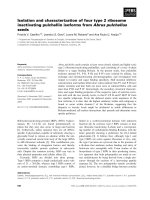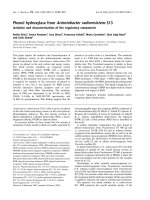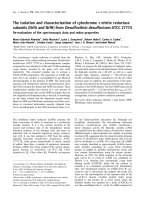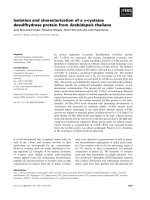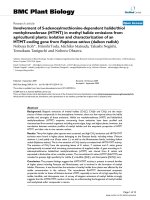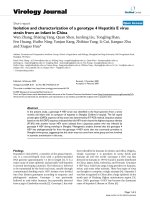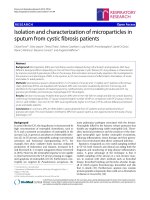Isolation and characterization of azotobacter spp obtained from yu coy soil samples in thanh hoa city (khóa luận tốt nghiệp)
Bạn đang xem bản rút gọn của tài liệu. Xem và tải ngay bản đầy đủ của tài liệu tại đây (2.11 MB, 51 trang )
VIETNAM NATIONAL UNIVERSITY OF AGRICULTURE
FACULTY OF BIOTECHNOLOGY
--------------
GRADUATION THESIS
TOPIC:
“ISOLATION AND CHARACTERIZATION OF
AZOTOBACTER SPP. OBTAINED FROM YU CHOY
SOIL SAMPLES IN THANH HOA CITY”
Student name
: Dang Hoang Son
Student’s code
: 637430
Class:
: K63CNSHE
Major:
: Biotechnology
Supervisor:
: Pham Thi Dung, Ph.D
Hanoi, 2022
GUARANTEE
I hereby declare that all results in this thesis are my own work under the
guidance of an Mrs. Pham Thi Dung Ph.D, Faculty of Biotechnology, Vietnam
National University of Agriculture. All data, images, and results presented in
this thesis are completely honest and have not been published in any other
works. The documents and information published in the works, journals, and
websites referenced in this thesis have been listed in the reference list of the
thesis.
I take responsibility for my promises to the board and the university.
Hanoi, December 2022
Student
Dang Hoang Son
i
ACKNOWLEDGEMENT
First words, in the process of completing this study, I have received great
deal of helps, guidance and encouragements from teachers and friends.
First of all, I would like to express my deepest thanks to my supervisor,
Mrs. Pham Thi Dung who given me suggestions on how to shape the study and
always been most willing and ready to give my valuable advice, helpful
comments as well as correction of my study.
Next, I would like to express my gratitude to all teachers in Faculty of
Biotechnology - Vietnam National University of Agriculture for their lectures 5
years that help me much in completing this study.
Last but not least, I would like to thank my family and my friends who
have always encouraged, supported and helped me to complete this study.
Ha Noi, December 2022
Student
Dang Hoang Son
ii
CONTENTS
GUARANTEE ....................................................................................................... i
ACKNOWLEDGEMENT .................................................................................... ii
CONTENTS ......................................................................................................... iii
LIST OF TABLES ................................................................................................ v
LIST OF FIGURES .............................................................................................. vi
ABBREVIATIONS ............................................................................................. vii
ABSTRACT ....................................................................................................... viii
CHAPTER I. INTRODUCTION....................................................................... 1
1.1. The urgency of this study ............................................................................... 1
1.2. Research purposes .......................................................................................... 2
1.3. Requirements.................................................................................................. 3
CHAPTER II. LITERATURE REVIEW ......................................................... 4
2.1. Overview of nitrogen fixing microorganisms ................................................ 4
2.1.1. Nitrogen cycle in nature .............................................................................. 4
2.1.2. Molecular nitrogen-fixing microorganisms ................................................ 5
2.1.3. Molecular nitrogen fixation process ........................................................... 6
2.2. Azotobacter species ........................................................................................ 8
2.2.1. Scientific classification ............................................................................... 8
2.2.2. Biological characteristics .......................................................................... 10
2.3. Status of research on isolation and characterization of Azotobacter spp.
from soil. ................................................................................................... 16
2.3.1. Studies on Azotobacter spp. in the world.................................................. 16
2.3.1. Studies on Azotobacter spp. in Vietnam ................................................... 16
CHAPTER III. MATERIALS, SUBJECTS AND RESEARCH METHODS 18
3.1. Subjects, materials and research location .................................................... 18
3.1.1. Research subjects ...................................................................................... 18
3.1.2. Materials, chemicals and research equipment .......................................... 19
iii
3.1.3. Place and time of the study ....................................................................... 20
3.2. Research Methods ........................................................................................ 21
3.2.1. Isolation of microorganisms ...................................................................... 21
3.2.2. Method of domestication and preservation ............................................... 22
3.2.3. Gram staining technique ........................................................................... 23
3.2.4. Identification of Azotobacter spp. by using moleculer marker ................. 25
3.2.5. Determine the nitrogen fixation capacity of Azotobacter spp. from each
sample. ...................................................................................................... 28
CHAPTER IV: RESULTS AND DISCUSSION ............................................ 30
4.1. Soil sampling ............................................................................................... 30
4.2. Results of isolation and identification of strains ......................................... 30
4.3. Result of Identification of Azotobacter spp. by using moleculer marker ... 33
4.3.1. Result of DNA Total electrophoresis ....................................................... 33
4.3.2. Result of DNA content by OD spectroscopy of total DNA ..................... 34
4.3.3. Results of PCR products detecting Azotobacter spp................................. 35
4.4. Qualitative results with Nessler reagent....................................................... 35
CHAPTER V. CONCLUSIONS AND RECOMMENDATIONS ................ 37
5.1 Conclusions ................................................................................................... 37
5.2 Recommendations ......................................................................................... 37
REFERENCES .................................................................................................... 38
iv
LIST OF TABLES
Table 3.1. Symbols, collection locations of all the soil sample .......................... 18
Table 3.2. Ashby medium’s component ............................................................. 20
Table 3.3. PCR reaction components .................................................................. 28
Table 4.1. Colonies forms obtained in all samples ............................................. 31
Table 4.2. Differential characteristics of the 3 strains of Azotobacter ............... 31
Table 4.3. Determination of DNA content by OD spectroscopy of total DNA .. 34
v
LIST OF FIGURES
Figure 3.1. Soil samples collected....................................................................... 18
Figure 3.2. The procedure of colorimetric method with Nessler reagent ........... 29
Figure 4.1. pH value of soil samples utilized for the isolation of Azotobacter .. 30
Figure 4.2. Single colonies cultured in Ashby medium, at 30 oC, dark
condition.............................................................................................. 31
Figure 4.3. Colonies were obtained when cultured in Ashby medium
containing mannitol and glucose ........................................................ 32
Figure 4.4. Result of DNA total electrophoresis ................................................. 34
Figure 4.5. Results of PCR products detecting Azotobacter gene by 27F and
1492R primers on gel agarose 1%, 100V ........................................... 35
Figure 4.6. The result of nitrogen fixation capacity of each sample on Ashby
medium................................................................................................ 36
vi
ABBREVIATIONS
A. beijerinckii: Azotobacter beijerinckii
BNF:
Biological Nitrogen Fixation
CTAB:
Cetyl Trimethyl Ammonium Bromide
DNA:
Deoxyribonucleic Acid
PCR:
Polymerase Chain Reaction
SS:
Soil sample
YC:
Yu Choy
vii
ABSTRACT
Isolation and selection of Azotobacter spp. from cultivated land. In this
study, bacterial strains were isolated from the soil growing Yu Choy at different
locations in Thanh Hoa city. These strains were biochemically identified and
characterized on Ashby – specific medium based on morphological and
physiological properties. Results obtained showed that all 3 isolated strains were
belonging to the Azotobacter strain. In order for molecular analysis, the 16S
rDNA gene was amplified using primer pairs (including 27F and 1492R
primers), and the PCR products are then subjected to electrophoresis to analyze
the result. Then determine the nitrogen fixation capacity of the samples by
colorimetric method with the Nessler reagent. The results showed that strain
YC03 has the strongest nitrogen fixation ability, and strain YC01 has the
weakest nitrogen fixation ability, and the strain YC02 was most suitable with the
characteristics of Azotobacter beijerinckii.
viii
CHAPTER I. INTRODUCTION
1.1. The urgency of this study
Along with the continuous development of industries, our country's
agriculture has also achieved many remarkable achievements thanks to the
advancement of science and technology, making the productivity and quality of
crops increased many times. In agriculture, nitrogen is considered a very
important source of nutrients for plants.
The supply of nitrogen to plants from fertilizers is extremely important to
meet the growth and development needs of plants and partly compensate for the
amount of nitrogen that plants have taken from the soil through crops.
When nitrogen fertilizer is applied to the soil, plants only absorb 40-50%
of the fertilizer, the rest is washed away by rainwater, irrigation water, or
converted and evaporated in the form of NH3, NOx, and N2. In addition, the
abuse of chemical fertilizers to increase productivity has degraded the land,
reduced fertility, polluted water sources, and affected the health and living
environment of people and the environment of other organisms in nature
(Shenoy, 2001). Therefore, the increase in chemical nitrogen fertilizer is only a
temporary solution and cannot be applied in the long term because it raises
many concerns.
Therefore, research and use of nutrients created from living activities of
microorganisms have been interested and developed by many countries around
the world. Currently, microbiological fertilizers have many advantages over
chemical fertilizers. In addition to improving crop productivity and quality,
reducing production costs, biofertilizers also make an important contribution to
environmental protection and sustainable agricultural development.
Many research results on microbial fertilizers have confirmed that the
effectiveness of microbial fertilizers depends on biological activity, ability to
1
compete with microorganisms available in the soil, and ability to adapt to soil
environmental conditions of microorganisms used in feces. Microbial fertilizers
are particularly useful if the microorganisms used are biologically active.
One of the research directions that is of interest is the production of
nitrogen-fixing microbial fertilizers derived from microorganisms, in which,
Azotobacter is the most interesting strain because of many characteristics such
as the ability to fix nitrogen naturally Because, in the air, many plant growth
stimulants (IAA, GA3, ...) are synthesized to help the root system develop
firmly, absorb water and nutrients well (Okon, 1985), contribute to raising the
humidity level soil fertility, stimulating growth, increasing crop yields, limiting
chemical fertilizers, and developing sustainable ecological agriculture.
To produce good microbial fertilizers, there must be strains of
microorganisms with high biological activity, multi-activity, and high viability.
Therefore, the isolation and characterization of microbial strains is
indispensable.
In Vietnam, there have been a number of studies on the characteristics of
Azotobacter on some soils, but currently, but currently there are not many indepth studies on Azotobacter strains, especially on soil samples in Thanh Hoa
province.
Starting from the above basis, I carried out the research: “Isolation and
characterization of Azotobacter spp. obtained from Yu Choy soil samples in
Thanh Hoa city”
1.2. Research purposes
Isolation and characterization of Azotobacter spp. from 5 soil samples of
Yu Choy obtained from different locations in Thanh Hoa city then determine
morphological characteristics and their nitrogen fixation capacity of them.
2
1.3. Requirements
Isolation of Azotobacter spp. from soil samples. Gram staining to
determine the morphology and biological characteristics of the bacteria. By the
16S rDNA amplification to determine the Azotobacter spp.. Then, determine the
nitrogen fixation capacity of them by using colorimetric method with Nessler
reagent.
3
CHAPTER II. LITERATURE REVIEW
2.1. Overview of nitrogen fixing microorganisms
2.1.1. Nitrogen cycle in nature
According to Aasfar et al (2021), nitrogen is an important and
indispensable nutrient source for animals, plants and even microorganisms. The
amount of nitrogen stored in nature is very large; In air, nitrogen makes up
78.16% by volume. It is estimated that the atmosphere that covers one hectare of
land contains up to 8 million tons of nitrogen. This amount of nitrogen can
provide plants for tens of millions of years (if plants are able to assimilate it).
Plants do not assimilate organic nitrogen directly, but must rely on
microorganisms to decompose and convert sustainable nitrogen sources into
easily digestible forms (NH3 or NH4+), providing a source of nitrogen nutrients
for plants. This process is called ammonification.
Following the process of ammonification, the microorganisms again
convert from NH3 to NO3- called nitrification. Following the nitrification
process, microorganisms convert NO3- to N2 to compensate for nitrogen in the
air, this is the denitrification process.
Under the action of microorganisms, nitrogen in the air is converted into
nitrogen-containing organic compounds called molecular nitrogen fixation.
All processes: immobilization - decomposition - metabolism and
nitrification reactions always occur under the action of microorganisms and
create a nitrogen balance. Thanks to that, it closes the nitrogen cycle in nature.
4
Nitrogen cycle in nature diagram
Source: Sarthaks.com
The nitrogen-based compounds produced from nitrogen fixation are taken
up into the tissues of algae and plants. Animals eat the algae and plants, thereby
taking up the compounds in their own tissues. Animals use the compounds in
their cells, or the compounds are broken down and excreted in the form of urea
and other waste products. Nitrogen-based compounds released as wastes or
occurring in the bodies of dead organisms are converted to ammonia and
subsequently to nitrates and nitrites. These compounds are then converted again
to atmospheric nitrogen by so-called denitrifying bacteria in the environment.
2.1.2. Molecular nitrogen-fixing microorganisms
According to Patil et al (2020), nitrogen-fixing microorganisms have an
important role in the N2 cycle and provide a significant amount of nitrogen to
plants. According to calculations by scientists, groups of microorganisms'
nitrogen fixation BNF (Biological Nitrogen Fixation) can provide up to 240 x
5
160 tons of N/year on the whole planet, 6 times more than the amount of
nitrogen that the whole world produces. produced by chemical means.
Nitrogen-fixing microorganisms are groups of microorganisms capable of
converting the abundant N2 gas in the atmosphere (79%) into the form of NH4+
for plants.
There are two groups of nitrogen-fixing microorganisms:
- Group of free-living microorganisms: Azotobacter, Clostridium
bacteria, ...
- Group of symbiosis microorganisms: Rhizobium, Azospirillum
Some other nitrogen fixing microorganisms:
In
addition
to
the
above-mentioned
molecular
nitrogen-fixing
microorganisms, there are countless other varieties that have the ability to fix
molecular nitrogen, they have many meanings in agricultural, forestry and
fishery production (Patil et al., 2020).
- Bacteria: Azotomonas insolita, Azotomonas fluorescens, Pseudomonas
azotogenis, Klabsiella pneumonia, Aerobacter aerogene, Rhodospirillum
rubrum, Chromatium, Rhodomicribium, Desulfovibrio desulfuricans,…
- Actinomycetes: Some species of the genera Actinomyces, Frankia,
Nocardia, Actinopolyspora
- Algae - Cyanobacteria: Pectonema, Anabaena azolla, Anabaena cylindrica,
Calothrix elenkii, …
2.1.3. Molecular nitrogen fixation process
According to Patil et al (2020), nitrogen fixation is a chemical process by
which molecular nitrogen (N2), with a strong triple covalent bond, in the air is
converted into ammonia (NH3) or related nitrogenous compounds, typically in
soil or aquatic systems but also in industry. Atmospheric nitrogen is molecular
dinitrogen, a relatively nonreactive molecule that is metabolically useless to all
but a few microorganisms. Biological nitrogen fixation or diazotrophy is an
6
important microbials mediated process that converts dinitrogen (N2) gas to
ammonia (NH3) using the nitrogenase protein complex.
Nitrogen fixation is essential to life because fixed inorganic nitrogen
compounds are required for the biosynthesis of all nitrogen-containing organic
compounds, such as amino acids and proteins, nucleoside triphosphates, and
nucleic acids. As part of the nitrogen cycle, it is essential for agriculture and the
manufacture of fertilizer. It is also, indirectly, relevant to the manufacture of all
nitrogen chemical compounds, which includes some explosives, pharmaceuticals,
and dyes.
Nitrogen fixation is carried out naturally in soil by microorganisms
termed diazotrophs that include bacteria, such as Azotobacter, and archaea.
Some nitrogen-fixing bacteria have symbiotic relationships with plant groups,
especially legumes. Looser non-symbiotic relationships between diazotrophs
and plants are often referred to as associative, as seen in nitrogen fixation on rice
roots. Nitrogen fixation occurs between some termites and fungi. It occurs
naturally in the air by means of NOx production by lightning.
All biological reactions involving the process of nitrogen fixation are
catalyzed by enzymes called nitrogenases. These enzymes contain iron, often
with a second metal, usually molybdenum but sometimes vanadium.
Biological nitrogen fixation (BNF) occurs when atmospheric nitrogen is
converted to ammonia by a nitrogenase enzyme. The overall reaction for BNF is:
N2 + 16ATP + 16H2O + 8e- + 8H+ 2NH3 + H2 + 16ADP + 16Pi
The process is coupled to the hydrolysis of 16 equivalents of ATP and is
accompanied by the co-formation of one equivalent of H2. The conversion of N2
into ammonia occurs at a metal cluster called FeMoco, an abbreviation for the
iron-molybdenum cofactor. The mechanism proceeds via a series of protonation
and reduction steps wherein the FeMoco active site hydrogenates the N2
substrate. In free-living diazotrophs, nitrogenase-generated ammonia is
7
assimilated into glutamate through the glutamine synthetase/glutamate synthase
pathway. The microbial nif genes required for nitrogen fixation are widely
distributed in diverse environments.
Nitrogenases are rapidly degraded by oxygen. For this reason, many bacteria
cease the production of the enzyme in the presence of oxygen. Many nitrogenfixing organisms exist only in anaerobic conditions, respiring to draw down oxygen
levels, or binding the oxygen with a protein such as leghemoglobin.
Schematic representation of the nitrogen cycle
Source: Quizbiology.com
2.2. Azotobacter species
2.2.1. Scientific classification
Domain
:
Bacteria
Phylum
:
Pseudomonadota
Class
:
Gammaproteobacteria
Order
:
Pseudomonadales
Family
:
Pseudomonadaceae
Genus
:
Azotobacter
8
Azotobacter species cells, stained with Heidenhain's iron hematoxylin
Source: Wikipedia.org
According to Patil et al (2020), Azotobacter is a genus of usually motile,
oval, or spherical bacteria that form thick-walled cysts (and also have hard crust)
and may produce large quantities of capsular slime.
They are aerobic, free-living soil microbes that play an important role in
the nitrogen cycle in nature, binding atmospheric nitrogen, which is inaccessible
to plants, and releasing it in the form of ammonium ions into the soil (nitrogen
fixation). In addition to being a model organism for studying diazotrophs, it is
used by humans for the production of biofertilizers, food additives, and some
biopolymers.
The first representative of the genus, Azotobacter chroococcum, was
discovered and described in 1901 by Dutch microbiologist and botanist Martinus
Beijerinck. Azotobacter species are Gram-negative bacteria found in neutral and
alkaline soils, in water, and in association with some plants.
According to Becking et al (1974), Azotobacter has the following species:
9
- Azotobacter agilis
- Azotobacter beijerinckii
- Azotobacter chroococcum
- Azotobacter vinelandii
According to FAO (1982), Azotobacter has the following common
species:
- Azotobacter agilis
- Azotobacter armeniacus
- Azotobacter beijerinckii
- Azotobacter chroococcum
- Azotobacter nigricans
- Azotobacter salinestris
- Azotobacter tropicalis
- Azotobacter vinelandii
2.2.2. Biological characteristics
2.2.2.1. Morphological characteristics
According to Aasfar et al (2021), cells of the genus Azotobacter are
relatively large for bacteria (2–4 μm in diameter). They are usually oval but may
take various forms from rods to spheres. In microscopic preparations, the cells
can be dispersed or form irregular clusters or occasionally chains of varying
lengths.
In fresh cultures, cells are mobile due to the numerous flagella. Later, the
cells lose their mobility, become almost spherical, and produce a thick layer of
mucus, forming the cell capsule. The shape of the cell is affected by the amino
acid glycine, which is present in the nutrient medium peptone.
In aging, cells are often covered with a thick sheath and form cysts. When
the living environment is not favorable such as changing the concentration of
nutrients or adding some organic substances such as ethanol or butanol-n. When
10
conditions are favorable, the cyst will rupture and form new cells. Azotobacter
spp. is less likely to form cysts in liquid media.
On solid media, colonies of Azotobacter are slimy, elastic, rather convex,
sometimes wrinkled. When aged, colonies are yellow-green, yellow or brownblack. Colony color is one of the criteria for classifying Azotobacter species.
In soil, Azotobacter commonly exists the following species:
- Azotobacter chrococcum: Cell size 2.0 x 3.1 µm, capable of forming
cysts, capable of motility. Colonies when aged are dark brown, pigments do not
diffuse into the medium, and are able to assimilate mannitol, ramnose, and
starch.
- Azotobacter beijerinckii: Cell size: 2.4 x 5.0 µm, capable of forming
cysts, not mobile. When old, it is yellow or light-brown. Pigment does not
diffuse into the medium. Able to assimilate mannite, ramnose, can't assimilate
starch but can assimilate sodium benzoate.
- Azotobacter vinelandii: Cell size 1.5 x 3.4 µm, cyst-forming, mobile. It
produces fluorescent pyoverdine pigments, pigments diffused into the medium,
capable of assimilating mannitol, ramnose, and sodium benzoate.
- Azotobacter agilis: Cell size 2.8 x 3.3 µm, non-cystic, mobile. When the
colony is old, it is yellow-green fluorescence, the pigment diffuses into the
medium, and it is not able to assimilate mannitol, ramnose, and sodium
benzoate.
Under magnification, the cells show inclusions, some of which are colored.
In the early 1900s, the colored inclusions were regarded as "reproductive grains",
or gonidia – a kind of embryo cells. However, the granules were later determined to
not participate in the cell division. The colored grains are composed of volutin,
whereas the colorless inclusions are drops of fat, which act as energy reserves.
11
2.2.2.2. Cysts
Aasfar et al (2021), cysts of the genus Azotobacter are more resistant to
adverse environmental factors than vegetative cells; in particular, they are twice
as resistant to ultraviolet light. They are also resistant to drying, ultrasound,
gamma, and solar irradiation, but not to heating.
The formation of cysts is induced by changes in the concentration of
nutrients in the medium and the addition of some organic substances such as
ethanol, n-butanol, or β-hydroxybutyrate. Cysts are rarely formed in liquid
media. The formation of cysts is induced by chemical factors and is
accompanied by metabolic shifts, changes in catabolism, respiration, and
biosynthesis of macromolecules; it is also affected by aldehyde dehydrogenase
and the response regulator AlgR.
The cysts of Azotobacter are spherical and consist of the so-called "central
body" – a reduced copy of vegetative cells with several vacuoles – and the "twolayer shell". The inner part of the shell is called intine and has a fibrous
structure. The outer part has a hexagonal crystalline structure and is called exine.
The exine is partially hydrolyzed by trypsin and is resistant to lysozyme, in
contrast to the central body. The central body can be isolated in a viable state by
some chelation agents. The main constituents of the outer shell are
alkylresorcinols composed of long aliphatic chains and aromatic rings.
Alkylresorcinols are also found in other bacteria, animals, and plants.
12
Azotobacter cyst
Source: Microbewiki.kenyon.edu
2.2.2.3. Germination of cysts
A cyst of the genus Azotobacter is the resting form of a vegetative cell;
however, whereas usual vegetative cells are reproductive, the cyst of
Azotobacter does not serve this purpose and is necessary for surviving adverse
environmental factors. Following the resumption of optimal environmental
conditions, which include a certain value of pH, temperature, and source of
carbon, the cysts germinate, and the newly formed vegetative cells multiply by a
simple division (Aasfar et al., 2021)
During germination, the cysts sustain damage and release a large
vegetative cell. Microscopically, the first manifestation of spore germination is
the gradual decrease in light refractive by cysts, which is detected with phase
contrast microscopy. Germination of cysts takes about 4–6 h. During
germination, the central body grows and captures the granules of volutin, which
were located in the intima (the innermost layer). Then, the exine bursts, and the
vegetative cell is freed from the exine, which has a characteristic horseshoe
shape. This process is accompanied by metabolic changes.
13
Immediately after being supplied with a carbon source, the cysts begin to
absorb oxygen and emit carbon dioxide; the rate of this process gradually
increases and saturates after four hours. The synthesis of proteins and RNA
occurs in parallel, but it intensifies only after five hours after the addition of the
carbon source. The synthesis of DNA and nitrogen fixation are initiated 5 hours
after the addition of glucose to a nitrogen-free nutrient medium.
Germination of cysts is accompanied by changes in the intima, visible
with an electron microscope. The intima consists of carbohydrates, lipids, and
proteins and has almost the same volume as the central body. During the
germination of cysts, the intima hydrolyses and is used by the cell for the
synthesis of its components (Aasfar et al., 2021).
2.2.2.4. Physiological properties
According to Aasfar et al (2021), Azotobacter respires aerobically,
receiving energy from redox reactions, using organic compounds as electron
donors, and can use a variety of carbohydrates, alcohols, and salts of organic
acids as sources of carbon.
Azotobacter can fix at least 10 μg of nitrogen per gram of glucose
consumed. Nitrogen fixation requires molybdenum ions, but they can be
partially or completely replaced by vanadium ions. If atmospheric nitrogen is
not fixed, the source of nitrogen can alternatively be nitrates, ammonium ions,
or amino acids. The optimal pH for growth and nitrogen fixation is 7.0–7.5, but
growth is sustained in the pH range from 4.8 to 8.5. Azotobacter can also grow
mixotrophically, in a molecular nitrogen-free medium containing mannose; this
growth mode is hydrogen-dependent. Hydrogen is available in the soil, thus this
growth mode may occur in nature.
While growing, Azotobacter produces flat, slimy, paste-like colonies with
a diameter of 5–10 mm, which may form films in liquid nutrient media. The
14
colonies can be dark-brown, green, or other colors, or maybe colorless,
depending on the species. The growth is favored at a temperature of 20–30°C.
Bacteria of the genus Azotobacter are also known to form intracellular
inclusions of polyhydroxyalkanoates under certain environmental conditions
(e.g. lack of elements such as phosphorus, nitrogen, or oxygen combined with an
excessive supply of carbon sources).
2.2.2.5. Pigments
Azotobacter produces pigments. For example, Azotobacter chroococcum
forms a dark-brown water-soluble pigment melanin. This process occurs at high
levels of metabolism during the fixation of nitrogen and is thought to protect the
nitrogenase system from oxygen. Other Azotobacter species produce pigments
from yellow-green to purple colors, including a green pigment that fluoresces
with a yellow-green light and a pigment with blue-white fluorescence (Aasfar et
al., 2021)
2.2.2.6. Distribution
According to Aasfar et al (2021), Azotobacter is mainly distributed in soil
and includes 6 common species, the distribution between species in nature is
very different, influenced by many factors. The most common is A. Chrococcum
- characteristic on grasslands. Some species are distributed in pond water,
especially A. Agilis, A. Vinelandii.
In different soil types, the number of Azotobacter is also different
(Hossain M. A, 2008). Azotobacter is usually found in neutral or alkaline soil, in
soil with pH < 6.0, Azotobacter is less likely to occur. The acidic environment is
very detrimental to the growth and survival of Azotobacter, adversely affecting
their nitrogen fixation. Therefore, the distribution of Azotobacter is also pH
dependent.
15
In 1961, 148 soil samples tested by Becking showed that all soil samples
with pH > 7.5 contained Azotobacter and in the pH range 7-7.4; 6.5-6.9; 6.0-6.4
showed Azotobacter with the rate of 89%, 57%, 32%.
Most Azotobacter species can only grow at pH greater than 6, so they are
hardly found in acidic soils. For acidic soils, the species Az. Indicum is typical.
indicum can grow in an environment with pH 3. Azotobacter requires higher
humidity than many other bacteria, so it is also less common in arid regions.
2.3. Status of research on isolation and characterization of Azotobacter spp.
from soil.
2.3.1. Studies on Azotobacter spp. in the world
Ridvan Kizilkaya (2009) evaluated the nitrogen fixation ability of
Azotobacter in Ashby culture medium and in different soil media such as
humus, dry soil, clay, in which, nitrogen fixation ability of Azotobacter on
Ashby medium for 3 days of culture was from 3.5 to 29.35 microgram N/ml, the
average was 10.24 higher than other soil media.
(Gupta & Pandher, 1998) showed that infection with Azotobacter sp
stimulated seed germination, rooting and growth, wheat and maize yield
increased by 10-15% compared to the control.
2.3.1. Studies on Azotobacter spp. in Vietnam
Some domestic research projects on Azotobacter strain (Trần Thị Linh,
2012):
- Do Thu Ha (2008), isolated 8 strains of Azotobacter capable of nitrogen
fixation and 2 strains capable of producing IAA from 30 acres of rice, vegetable
and fallow land in Binh Ky village - Da Nang city. In which, selecting 2 strains
with the strongest activity can be applied to the production of microbial
fertilizers.
- Nguyen Thi Luyen (2011) isolated 10 strains of Azotobacter spp from 30
acres of corn, mung bean and rice cultivation in Long Khanh district - Dong Nai.
16
